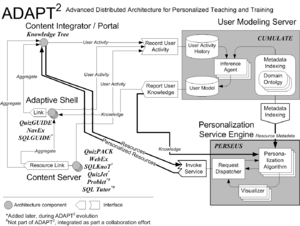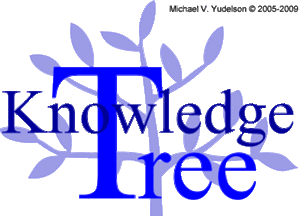Difference between revisions of "ADAPT2"
(→Overview) |
|||
| Line 11: | Line 11: | ||
* [[PERSEUS]] - personalization service engine | * [[PERSEUS]] - personalization service engine | ||
| − | To provide personalized service to its end users, these components communicate with each other using several standard communication protocols. Two main groups of protocols are [[Content Invocation protocols]], which enable a portal or an adaptive shell to call interactive learning objects residing on various content servers, and [[User Modeling protocols | + | To provide personalized service to its end users, these components communicate with each other using several standard communication protocols. Two main groups of protocols are [[Content Invocation protocols]], which enable a portal or an adaptive shell to call interactive learning objects residing on various content servers, and [[CUMULATE protocol|User Modeling protocols]] for reporting user activities and requesting current state of their knowledge from user-modeling servers. |
A typical personalized learning system supported by [[ADAPT2|ADAPT<sup>2</sup>]] works in the following way: | A typical personalized learning system supported by [[ADAPT2|ADAPT<sup>2</sup>]] works in the following way: | ||
Revision as of 23:46, 20 January 2025
Contents
Overview
ADAPT2 (read adapt-square) - Advanced Distributed Architecture for Personalized Teaching and Training - is a framework for research on personalized and adaptive learning, which brings together researchers exploring novel types of interactive learning content with researchers exploring various kinds of personalization approaches. As a part of its mission, ADAPT2 currently provides personalized learning systems to support large classes for several computer science education topics such as Java, Python, and SQL. It has been used in many universities on four continents.
ADAPT2 consists of the following principal component types.
- Portals, such as Knowledge Tree, which provide a single sign-on point for users of personalized learning systems
- User-modeling servers such asCUMULATE, which maintain knowledge models of individual students
- Content Servers, which provide access to various kinds of interactive learning objects
- Adaptive Shells, which offer various kinds of personalized access to learning objects
- PERSEUS - personalization service engine
To provide personalized service to its end users, these components communicate with each other using several standard communication protocols. Two main groups of protocols are Content Invocation protocols, which enable a portal or an adaptive shell to call interactive learning objects residing on various content servers, and User Modeling protocols for reporting user activities and requesting current state of their knowledge from user-modeling servers.
A typical personalized learning system supported by ADAPT2 works in the following way:
- Students log in through a portal, such as Knowledge Tree or a regular learning management system, which determines which courses (learning groups) they can access. To start learning, students choose one of these courses.
- A selected course provides access to one or more adaptive shells, such as MasteryGrids. Each of these shells provides personalized access to multiple kinds of learning content made accessible for the course. The selected course also determines which student modeling server will be used for personalization.
- Using the current state of the user models, which the adaptive shell requests from the user-modeling server, the shell helps each student find and launch an interactive learning object that is most appropriate for the current state of their knowledge.
- While the students work with the selected interactive learning object, all their activities are reported back to the user-modeling server, which uses these activities to update the state of individual learners' knowledge.
- After completing their work with each learning object, the students return to the adaptive shell, which now uses the updated state of the user model to assist the learners with selecting the next knowledge- and context-appropriate learning object.
The personalized learning process supported by ADAPT2 is quite typical for personalized learning. The difference made by ADAPT2 is the ability to integrate components developed by multiple research teams. A research team exploring specific kind of learning objects could release them in a new content server and re-use other components (portals, user-modeling servers, adaptive shells) to explore these objects in a realistic context along with other types of objects. A team that explores new approaches for user modeling or personalization could develop new types of user-modeling servers and adaptive shells and reuse components developed by other teams. ADAPT2 promotes collaboration and enables each team to focus on the type of learning technology that they want to explore.
The original design of the ADAPT2 architecture was presented in the following papers:
- Brusilovsky, P. and Nijhawan, H. (2002) A Framework for Adaptive E-Learning Based on Distributed Re-usable Learning Activities. In: M. Driscoll and T. C. Reeves (eds.) Proceedings of World Conference on E-Learning, E-Learn 2002, Montreal, Canada, October 15-19, 2002, AACE, pp. 154-161.Brusilovsky, P. (2004) KnowledgeTree: A distributed architecture for adaptive e-learning. In: Proceedings of 13th International World Wide Web Conference, WWW 2004, New York, NY, 17-22 May, 2004, ACM Press, pp. 104-113.
- Brusilovsky, P., Sosnovsky, S., and Yudelson, M. (2004) Adaptive Hypermedia Services for E-Learning. In: Proceedings of Workshop on Applying Adaptive Hypermedia Techniques to Service Oriented Environments at the Third International Conference on Adaptive Hypermedia and Adaptive Web-Based Systems (AH'2004), Eindhoven, the Netherlands, August 23, 2004, Technische University Eindhoven, pp. 470-479.
Over the years, the infrastructure has been expanded with support of several projects such as Personalized Access to Open Corpus Educational Resources through Adaptive Navigation Support and Adaptive Visualization and Adaptive Navigation Support and Open Social Learner Modeling for PAL. We developed several adaptive shells to explore a range of personalization approaches and collaborated with many research teams to offer a broad set of interactive learning objects for computer science education. Currently, we are integrating ADAPT2 into a larger community-oriented infrastructure that is being developed by NSF-supported Infrastructure project Community-Building and Infrastructure Design for Data-Intensive Research in Computer Science Education.
Knowledge Tree
| Knowledge Tree is a link aggregating portal. It presents content structured according to the folder-document paradigm. Knowledge Tree provides authentication and authorization and implements a simplified form of access control. It supports collaborative authoring and social annotation. (more) |
CUMULATE
CUMULATE is a central user modeling server responsible for collecting evidence of user activity and for generating user models, i.e., assertions about the knowledge and mastery of individual users. Personalization components of the architecture, such as personalized shells and personalized learning content, could get access to the user models (using CUMULATE protocols) to offer personalized access and other personalized services to the end users. ==> (more on CUMULATE)
Adaptive Shells
ADAPT2 supports multiple types of adaptive shells (aka value-adding services) which are the key components for providing adaptation and personalization. Adaptive shells stand between a portal and learning objects coming from multiple content servers. In contrast to the portal, which is not personalized, adaptive shells can provide personalized access to learning objects. The ability to insert various adaptive shells between the portal and the learning content makes possible to explore various personalization approaches. Examples of adaptive shells explored by our lab in the past include:
- NavEx for concept-based personalization
- QuizGuide and [JavaGUide]] for topic-based personalization
- Knowledge Sea II for social navigation support
- Progressor shells for a single-content social comparison
- Progressor+ shell for multi-type social comparison
Since 2015 most of our research uses MasteryGrids shell. MasteryGrids offers a flexible and customizable interface for delivering and exploring personalized content access. It combines knowledge-based personalization explored by NavEx and QuizGuide with social navigation and comparison ideas explored by Knowledge Sea II, Progressor, and Progressor+.
Content Servers
Content servers provide learning objects for students to interact with. Content servers that natively work with ADAPT2 include several systems developed by PAWS lab: WebEx, QuizPACK, c/jWADEIn, SQLKnoT, QuizJET, PCEX. ADAPT2 can also use learning objects developed by many other research teams. There are currently two ways to make interactive learning content usable in ADAPT2.
- For unrestricted use, learning content server has to implement with ADAPT2 content invocation protocol and CUMULATE knowledge reporting protocols. Examples of of content servers that implement these protocols are SQL Tutor (University of Canterbury, New Zealand), PCRS (University of Toronto), and ACOS server (Aalto University).
- For the use in MasteryGrids interface only, a learning content server has to implement LTI protocol for launching learning activities and reporting learner progress. Examples of LTI-compatible learning content that are currently used in courses supported by ADAPT2 are CodeWorkout (Virginia Tech) and DBQA (University of St. Thomas).
ADAPT2 Protocols
Communication protocols enable multiple components of ADAPT2 to work together in a coordinated way. A new component could be easily integrated into the infrastructure as long as it communicates with other components using these standardized protocols. Two main groups of ADAPT2 protocols are
- Content Invocation protocols, which enable a portal or an adaptive shell to call interactive learning objects residing on various content servers
- CUMULATE protocol for reporting user activities and requesting the current state of their knowledge from user-modeling servers.
PERSEUS
PERSEUS is a Personalization Service Engine. It provides adaptive support for non-personalized (educational) hypermedia systems by abstracting content presentation/aggregation from user modeling. PERSEUS protocols are based on RDF and RSS 1.0. Although, PERSEUS was initially developed for ADAPT2 framework, its data model permits seamless support of any other hypermedia application. Currently PERSEUS supports social navigation, topic-based navigation, concept-based navigation, and adaptive filtering techniques.
Standardization
Data models of ADAPT2 components are partially serialized as RDF. For more information refer to ADAPT2 RDF Binding.



